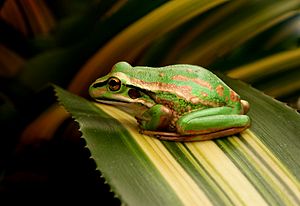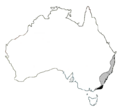Green and golden bell frog facts for kids
Quick facts for kids Green and golden bell frog |
|
|---|---|
 |
|
| Conservation status | |
| Scientific classification | |
| Genus: |
Ranoidea (genus)
|
| Species: |
aurea
|
| Synonyms | |
|
|
The green and golden bell frog (Litoria aurea) is a special frog that lives in Australia. It can also be found in New Zealand, where it is an invasive species. This means it was brought there by people and now lives in a new place.
These frogs are super cool because of their bright colors! They are mostly green with shiny bronze spots. They also have black stripes that go from their noses, over their ears, and down their bodies. Their bellies are white, and parts of their legs can be a bright blue. Did you know these frogs even have teeth?
Male adult frogs usually grow to be about 5.7 to 6.9 centimeters long. Female frogs are a bit bigger, reaching 6.5 to 10.8 centimeters in length.
Green and golden bell frogs are not very good at climbing. They prefer to live near water, like ponds or puddles, especially those without fish. This is because fish might eat their eggs or tadpoles. These frogs will eat almost anything they can catch, even other green and golden bell frogs!
Contents
Life Cycle and Reproduction
Green and golden bell frogs lay a huge number of eggs at one time, usually between 3,000 and 10,000! When they first lay their eggs, they float together on top of the water. After a while, the eggs sink down.
When the eggs hatch, tiny tadpoles come out. These tadpoles are busy eaters! They munch on things like algae, tiny bacteria, and even dead bits of plants or animals in the water.
Why They Are Special
There used to be so many green and golden bell frogs that people would catch them. They were sometimes used to feed pet snakes or for studying in school science classes.
However, by the 1990s, scientists noticed that there were far fewer green and golden bell frogs. This happened for a few reasons:
- Habitat loss: People started building more things, like roads and buildings. This broke up the places where the frogs lived, making it harder for them to move around and find food or mates.
- New animals: Invasive species like the Eastern mosquitofish were brought into the frogs' habitats. These fish eat the tiny green and golden bell frog tadpoles, which means fewer frogs grow up.
In 2000, something amazing happened during the building of tennis courts for the 2000 Summer Olympics. Workers found green and golden bell frogs nearby! Because these frogs are special, the builders stopped working to protect them.
Green and Golden Bell Frogs in New Zealand
The green and golden bell frog is an invasive species in New Zealand. This means it's not naturally from there. In the 1860s, a group called the Auckland Acclimatisation Society actually released these frogs in New Zealand on purpose.
The frogs that were released on New Zealand's South Island did not survive. The weather there was not good for them. But today, you can still find them living on New Zealand's North Island.
Images for kids
-
Ranoidea aurea (left) was once thought to be a type of Rana frog (right). They look similar with pointy noses, long legs, and webbed toes.
See also
 In Spanish: Rana campanilla verde dorada para niños
In Spanish: Rana campanilla verde dorada para niños








